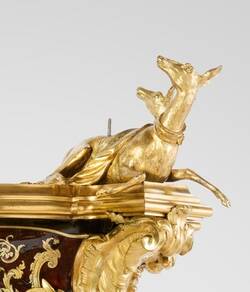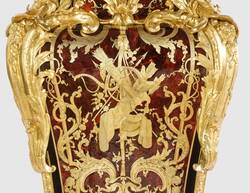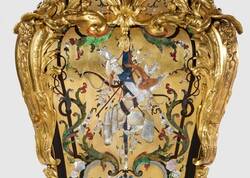Further Media
The model of the Pendule aux biches, a clock resting on the backs of four sculpted does (French: biches) and crowned by Diana, goddess of the hunt, on a high pedestal, is one of the outstanding creations of 18th-century Parisian cabinetmaking. The model is believed to have been designed by the Parisian cabinetmaker Bernard I van Risenburgh (BVRB I; 1670–1738), who came from the Netherlands. This attribution is based on an entry in his death inventory from 1738 for a ‘model of the pedestal and clock case on a doe’. The fact that Latz also produced this clock model is attested to by a pendulum clock in the collection of the Prussian Palaces and Gardens Foundation Berlin-Brandenburg. It bears the stamp of the Latz workshop. These two Dresden pieces are likely to be a kind of link between the production of BVRB I and the pendulum clock stamped by Latz in Potsdam.
object information
Jean-Pierre Latz (attributed)
Paris, ca. 1740
Pendule aux biches with marquetry in contre partie (brass ground with colored inlays)
construction: oak, soft wood
marquetry: tortoiseshell, brass, horn (with a colored background), pewter, copper, ebony
mounts: brass, mis en couleur d’or-treatment
measurings: h: 255,5 x w: 65 x d: 46 cm
Kunstgewerbemuseum, Inv.Nr. 53695 + 37667-2
The case, of which only fragments remain today, once formed a magnificent ensemble together with its corresponding pedestal. It has been documented in Dresden's Royal Palace since 1768. In the 18th and 19th centuries, the set was always displayed in rooms used by the court for official functions. To ensure that it retained its appearance, the ensemble underwent repeated and quite extensive restoration work in the 19th century.
When originally made, the space for the coloured inlays of horn, mother-of-pearl (shell), pewter or copper was created by cutting out the corresponding sections from the tortoiseshell of the already glued marquetry. The horn inlays in particular are very delicate and tend to come loose quickly. In the past, the missing areas were visually filled in with putty or colour retouching. During the 2024 restoration, PET plastic was used as a substitute for horn.
Jean-Pierre Latz (attributed)
Paris, ca. 1740
Pendule aux biches with marquetry in première partie (tortoiseshell ground with brass inlays)
construction: oak, soft wood
marquetry: tortoiseshell, brass
mounts: brass, mis en couleur d’or-treatment
measurings: h: 266 x w: 66 x d: 47 cm
Kunstgewerbemuseum, Inv.Nr. 37336-1 + 37336-2
This ensemble was most likely produced in the same manufacturing process as the coloured contre-partie ensemble. Both the construction and the marquetry are identical. The marquetry was most likely heavily reworked at the end of the 19th century. The red backing is likely to be a result of this measure, as this ensemble and its counterpart had previously always been described in inventories as having a black background.
Together with the other ensemble in première partie, this set has been documented since 1768 as part of the furnishings of the Moritzburg hunting lodge, where it was an ideal fit due to its pictorial programme featuring the crowning goddess of the hunt, Diana, and her does, as well as the trophy motif of the pedestal's marquetry.




